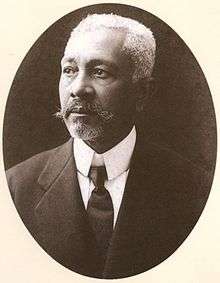Teodoro Fernandes Sampaio

Teodoro Fernandes Sampaio (7 January 1855 - 11 October 1937) was an Afro-Brazilian polymath and public intellectual who worked as an engineer, geographer, politician, and historian.[1]
Early life
Sampaio was born on the Engenho Canabrava, property of the Visconde de Aramaré in Santo Amaro, Bahia. His father was Manuel Fernandes Sampaio, a white priest, and his mother, Domingas da Paixão do Carmo, was enslaved.
Education
In 1864 his father took young Sampaio to São Paulo and Rio de Janeiro, where he studied engineering at the Colégio Central.
During his studies in Rio de Janeiro, Sampaio worked as a drafter and taught mathematics in the Museu Nacional.[2]
Sampaio graduated with a degree in civil engineering in 1877 and returned to Santo Amaro. Reunited with mother, Sampaio managed to purchase the manumission of his three brothers Martinho, Ezequiel, e Matias.
Engineering
In 1879, Emperor Pedro II of Brazil named Sampaio to the national "Comissão Hidráulica" (Hydraulic Commission). He was the only Brazilian serving on a team of U.S. engineers working to enlarge the port of Santos.[3]
Institutional Memberships
Sampaio was one of the founders of the Instituto Histórico e Geográfico de São Paulo (Historical and Geographical Institute of São Paulo) in 1894; a member of the Instituto Geográfico e Histórico da Bahia, serving as president in 1922, and a member of the Instituto Histórico e Geográfico Brasileiro (1902).
Historical Significance
Sampaio was the first person with an enslaved mother to become a federal deputy in Brazil's history.
His most important books were:
- O rio São Francisco e a chapada Diamantina (1906)
- O tupi na geografia nacional (1901),
- Atlas dos Estados Unidos do Brasil (1908)
- Dicionário histórico, geográfico e etnográfico do Brasil (1922)
- História da Fundação da Cidade do Salvador (póstumo).
Books about him:
- O Rio São Francisco e a Chapada Diamantina, Teodoro Sampaio (José Carlos Barreto de Santana org.), Companhia das Letras, São Paulo, 2002. (ISBN 85-359-0256-2)
- Theodoro Sampaio e a Chapada Diamantina (Trechos da expedição de 1879/1880), Otoniel Fernandes Neto, ed. do Author, Brasília, 2005. (ISBN 85-905834-1-4).
- Baianos Ilustres, Antônio Loureiro de Souza, Salvador, 1949.
External links
- http://biblio.etnolinguistica.org/autor ("Works by Teodoro Sampaio")
- http://mundoafro.atarde.com.br ("Reproduction of drawings by Teodoro Sampaio")
Bibliography
- "Theodoro Sampaio - nos sertões e nas cidades" Versal Editores, Rio de Janeiro, 2010. (ISBN 978-85-89309-26-4).
- O Rio São Francisco e a Chapada Diamantina, Teodoro Sampaio (José Carlos Barreto de Santana org.), Companhia das Letras, São Paulo, 2002. (ISBN 85-359-0256-2)
- Theodoro Sampaio e a Chapada Diamantina (Trechos da expedição de 1879/1880), Otoniel Fernandes Neto, ed. do Autor, Brasília, 2005. (ISBN 85-905834-1-4).
- Baianos Ilustres, Antônio Loureiro de Souza, Salvador, 1949.
References
- ↑ Schwarcz, Lilia Moritz (22 January 2011). "Theodoro Sampaio ajudou a integrar o país". Folha de S.Paulo Ilustrada. Retrieved 6 October 2014.
- ↑ Monteiro, Filipe (10 March 2008). "Revista de História". Retrieved 6 October 2014.
- ↑ Garcez, Lucas Norgueira (Abril–Junho 1958). "Teodoro Sampaio (Engenheiro)". Revista do Instituto Histórico e Geográfico Brasileiro (239): 152–160. Check date values in:
|date=(help)